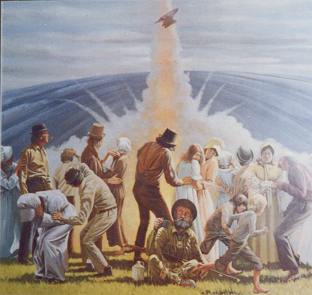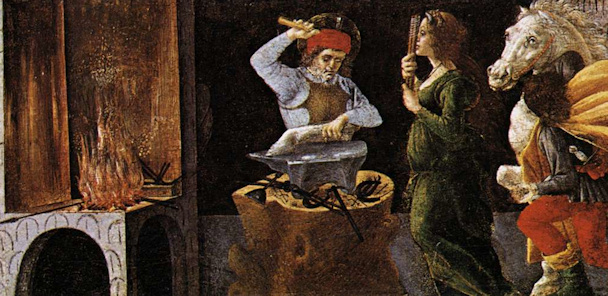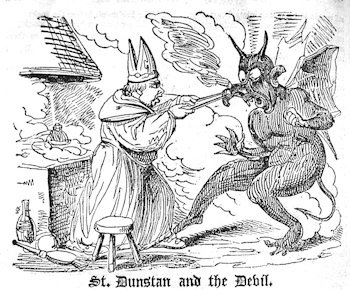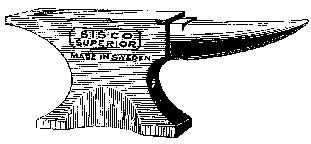N. Collier, Publisher
|
This page started out as one of our marketing tests. It has nothing to do with publishing or the internet, but it is an interesting hobby and historical tradition. We built the page and tried a few experiments, which resulted in thousands of hits! That was the point. |
ANVIL SHOOTING
Most of the following articles and snippets about anvil shooting
are taken from articles written by Neal Collier for his history column
in the Tri-City Ledger, Flomaton, Alabama. Some of this material will be
included in a book we hope to release at some time in the future. All material is
copyright 1993-2001 by Neal Collier. Credited fair use is permitted. Updated May 2011.
7-7-93
Well, I hope you had a good Fourth of July. I don't know how mine went because this is written a week in advance. July 4th is the day we celebrate our independence and we've had 200+ years to develop some traditions. Some part of the family might travel to see another part. A cookout or a day at the creek is a good bet. A cold watermelon and some fireworks are a must. Readers in Alabama probably don't appreciate firecrackers as much as do Floridians, who must smuggle them across the state line. Finally, no Independence Day celebration is complete until someone has shot the anvil.
Maybe you don't shoot the anvil in your neighborhood, but it was once a favored American tradition. Maybe anvils are getting too scarce. Now, when I say "shoot" I do not mean take a gun and blast away at the anvil. That would be dangerous because bullets tend to bounce off, traveling in uncertain directions. No, I mean shoot the anvil. 200 pounds of iron sailing through the air, leaving a voluminous cloud of gunpowder smoke at the point of departure. I'm told this is completely safe as long as one is neither hit by the anvil returning to earth or blown to pieces by mishandling gunpowder.
The way this works is you first find two anvils, some fuse, and a keg of black powder. One anvil is placed upside down in the street, or other open area. Don't try this indoors. There is usually a hollow in the base of the anvil and this is filled with a pound or so of powder. For the sake of perspective, there are 7000 grains in a pound of powder, and about 30 grains are used to launch a .44 caliber bullet from a Walker Colt. The fuse is directed from the powder to the outside world and the other anvil is placed, right side up, over the powder. This works best if you have well matched anvils. When the fuse ignites the powder, the upper anvil is launched with a bang, a puff, and a loud ringing. The anvil would be shot again and again until all the powder was gone. Traditionally, no one tries to catch it.
Rest assured, anvil shooting is not dead yet. Every
year at the big blacksmithing convention near Birmingham, anvils are shot,
sometimes topping 200 feet. I was going to try it this Independence Day,
but I forgot to stop at the gunpowder store.
9-22-93
I had some inquiries regarding the anvil shooting
at Tannehill Park during the blacksmith conference. I didn't go, but I
made some inquiries. The challenger was wanting to shoot for accuracy,
but a bunch from Mississippi wanted to shoot for range. They abandoned
the use of the traditional second anvil as a launching pad. Their launchers
were specially prepared to hold two full pounds of gunpowder. By means
of a transit and a calculator it was determined that some anvils were topping
300 feet!
August 17,1994
There is yet another who has joined the renaissance
of
sport anvil shooting. Bruce Graham, a noted amateur ornithologist of our
region joined the ranks last Saturday, or attempted to. There was an initial
equipment problem which stifled the hoped-for kaboom and severely limited
the altitude of the shot. Accuracy was excellent, though. It is hard to
go far afield when your anvil only lifts a few thousandths of an inch.
The red-faced ornithologist has returned to his apiary to work out the
problems of his launch system. Where's my hardhat? The first public anvil
shooting this area has seen in a while, if ever, is scheduled for this
December in Wawbeek. We'll have more word on that at a later date.
August 24, 1994
I wish to report that the anvil-shooting ornithologist
has been successful in at least two launches and is working feverishly
at improving his equipment. He has thrown down the gauntlet and the exhibition
planned for December in Wawbeek may turn into a competitive event. There
is just something about the combination of heavy iron and massive clouds
of gunpowder smoke that gets into a person's blood. We are still working
to trace the history of this nearly-lost American pastime. It appears that
it began to fade out with the importation of the Chinese firecracker in
the mid 1800's.
09-21-94
This past weekend there was an antique machinery show near Barnwell, Alabama, and I was there. These shows are fun because it gives us a chance to fire up the old contraptions, trade parts, and tell lies. When the public is invited, like with this one, some old timer will invariably come along and share some useful bit of information. This usually happens in the course of some reminiscence of how he worked on a machine just like that when he was a boy, or how he has one just like it out behind the barn...
Another reason I was there is that I had promised to blow the anvil, my first public demonstration. Folks still think I am pulling their legs on this, but it is for real. Mike Stringer, the current world record holder, was there. He and I are still doing research to find the beginnings of it all. I originally thought it had died off about 150 years ago. We have found evidence that it was alive and well in this century, though. The only written account of the subject that I have found is in Alex Bealer's THE ART OF BLACKSMITHING. Somebody knew about it, though, because folks were seeking me out to find out when it would happen again.
I have discovered that a few historical tourist attractions still practice anvil shooting, but only in the traditional way on July 4th. One old man I met this past weekend remembered the practice in his old Kentucky hometown, when he was a boy. Another, not old enough to know firsthand, told of the Arkansas blacksmith who blew his anvil in celebration of the signing of the World War One armistice. Another in that community mistook the explosions as a sure sign that the Germans had invaded, and began boarding up. I held back a little and put a 100 pound anvil 170 feet into the air. I've got to find another anvil for shooting, though, as I'm presently using my working anvil.
If shows like this are of interest to you, you are
in luck. This weekend is the Fall show at Tannehill State Park, near Birmingham.
October 8-9 is the Florida Artist Blacksmith Association at Barberville,
Florida's Pioneer Center for the Creative Arts. October 14-15 are Coden,
Alabama's Heritage Days. Pioneer Peanut Days begin October 22 at Landmark
Park in Dothan. Real close to home is the annual show at Chinquapin (chinkypin)
Park in Wawbeek, December 1-4. This is the only show mentioned that will
feature an anvil shooting competition.
April 5, 1995
As promised last week, we have the results of the 1995 World Championship Anvil Shoot. The big event was held this last weekend in Laurel, Mississippi, with fans coming from as far away as Michigan. We know how hard it is for you anvil shooting fans to get this news otherwise. The Acme Anvil Company team's Gene Mulloy turned in an altitude of just over 300 feet for third place. Bush Construction Company's "Shine" Stringer shot an impressive 427 for second place. First place went to the North Escambia Championship Team, based in Bogia. Team members are Chief Metallurgist and Fabricator David Blackwell, Advisor Nick "Y'all don't never listen" Blackwell, and Shooter Yours Truly. Our altitude of 615.47 feet gave us a decisive victory and a new world record.
Kids, don't try this at home, but study your physics
and chemistry, so someday you can grow up to do something really weird.
Back in 1875, Emily Dickinson wrote, "A little madness in the spring/ Is
wholesome even for a king."
April 17,1996
History has once again been made in America's fastest growing spectator sport. The Tri-City's own local anvil shooting team took the world championship title for the second straight year. Our local team was also hailed for having the deepest and classiest hoopla (actually, another term was used, but Dear Editor won't let us use it in The Ledger), with its mugs, belt buckles, stationery, cards, and flying anvil hood ornament. This news is a Tri-City Ledger exclusive. Other news crews were busy covering a flood of calls to the Civil Defense Headquarters, which always seems to occur during the competition!
On our trip to Laurel, Mississippi last weekend we also discovered some more lore regarding this age-old American tradition-turned-sport. Previously, we had heard that early settlers would fill a hole in the ground with gunpowder and contain it with an anvil to produce a cannon-like roar to scare the Indians. We had also heard that Yankee soldiers started the fad by trying to blow up a Southerner's valuable anvil, finding it difficult (it can be done), but a lot of fun in the trying. A conversation with an Austrian friend indicates the practice may even date back to the Old World, but there is some room for confusion in the translation.
One blacksmith at the shootout offered another explanation he had heard. I have known this man for a long time and can attest to his honesty at such times as his mouth is closed, and he said it with the utmost sincerity. He says that every blacksmith should periodically offer up his anvil to God as a token of appreciation for prosperity. Supposedly, if God wants the anvil He will take it. Otherwise the anvil will return to earth and the blacksmith will continue his business. As I said, the teller did seem sincere and during a recent equipment test my best anvil returned to earth with a generous tithe taken out.
The most reasonable story yet came from Cody, Wyoming. There is reportedly a painting there depicting an early anvil shoot. The story goes that an early wagon train of westward-bound settlers made camp near there in the last century. It was July 3rd, and the travelers thought fit to find some way of celebrating Independence Day. The traditional way was with the firing of cannon and there was nary a cannon to be found among them. One enterprising fellow thought that a spare wagon wheel hub might hold enough powder to make a celebratory bang. Another figured it would work better if his anvil were placed over the open end of the hub to contain things enough to build some pressure.
The wheel was placed flat on the ground, a double handful of powder was poured into the hub, a fuse was stuck into the powder, and the whole works was topped off with the anvil. Upon ignition, there was a pleasing bang and the anvil was sent merrily spinning and ringing. The painting is said to depict men and women applauding the event, children prancing about excitedly, and one old fellow with a jug, totally oblivious to it all. No doubt it couldn't match the awesome power of our team's Blackwell Blaster Mk. II, but the wagon wheel was entirely adequate for the occasion. I have been promised a photo of the painting. The usual disclaimer: Kids, don't try this at home!

12-11-96
As promised last week, I have further news on the history of anvil shooting. Some of you might complain that feet are being dragged in getting this story out. After all, it has been a couple of years that I've been writing about this and only sketchy information has been revealed. Some may still think this is all made up. Neither case is true.
Very little in modern literature relates any history of anvil shooting, anvil firing, anvil flying, anvil blowing, or anything else it might be called. We have to latch onto any shred of the story we can and keep collecting until we have it all. This latest round of information comes from Mr. Floyd Daniels, a retired, old-time anvil shooter. He supplied a photo for a recent Mobile Press Register story on the subject. Unfortunately, my copy of the photo for this story has not yet arrived. Old Floyd is getting forgetful. That photo showed an early twentieth-century shoot in Georgia where a great number of anvils were being fired in succession. This was the traditional method. The point was just to make a lot of noise and smoke with no particular importance put on altitude. Old timers like Floyd regard the modern competition-style shoots to be mere spectacle.
For this reason, the shoots at the tractor show in Wawbeek last week included both styles. Seven fuses were lit at once. The first six anvils merely flipped over with a small bang and a puff of white smoke. The seventh went over two hundred yards up with a mighty roar. It is unlikely that any of the spectators have ever seen or will ever again see seven anvils fired at one time.
In the Georgia photo, men are standing only a few feet from the flipping anvils. The small charges are not particularly dangerous, but they didn't have contingency-fee lawyers back then! Spectators at Chinquapin Park had to stay well back for the big shot and tall grass in the field obscured the view of the traditional shots. Not even tall pines obscured the last. Now back to the history.
Floyd also told me that there were three patron saints of blacksmiths: Clement, Dunstan, and Eloy. Well, just try finding material on these fellows. I ended up with a book called Curiosities of Popular Customs etc., etc., which came out in 1897. Get out your copy and follow along.
I learned that Eloy (or Eligius) was the patron saint of several European towns, of goldsmiths, and all metal workers in general. He lived from 588 to 659. A versatile fellow, he worked as a goldsmith and constructed some golden thrones for King Clotaire II. This got him a job as Secretary of State, because he made two thrones with the materials allocated for one. He later became a traveling evangelist. He still kept up his smithing and a couple of legends grew out of this. One time he was called upon to shoe a demon-possessed horse. Eloy cut the horse's leg off, installed the shoe, made the sign of the cross and stuck the leg back onto the astonished horse. Another time, he took some red-hot tongs and grabbedthe devil by the nose to keep him in line.

Here is a picture, so you know it is true.

This is St. Dunstan's claim to fame, too. Here he is using his blacksmith tongs on the Devil's nose!

That's what they say, anyway.

Clement lived in the first century. He is known as a patron saint of blacksmiths and farriers. It seems he was a blacksmith who became converted to Christianity and eventually became Bishop of Rome. Such lofty position did not protect him from an untimely death. His detractors tied him to an anchor and tossed him into the sea on November 23, 100. An anchor is his symbol in art.
Legend has it that he was the first man to shoe a horse and the first to found iron and other metals from ore. 100 years ago "Clemmening" was still celebrated in England, much like our halloween, with kids going door-to-door in quest of apples and other treats. Earlier it was the blacksmiths going door-to-door asking for beer or wine to go with their apples. I'll try to think to ask a London trading partner if this still goes on today.
The blacksmiths would celebrate by dressing someone up as "Old Clem" and letting him preside over the merriment. His scepters were tongs and hammer. Toasts would be made to Old Clem. Once sufficiently toasted, the Clem-du-jour would then lead a parade of staggering smiths through the town. This was as late as 1826.
Brighton Railway Company smiths held an annual dinner at the White Horse Inn. At some unknown point it became popular to fire the anvils with gunpowder. This had died out, though, by the turn of this (20th) century.
We still don't have the whole story, but we have now confirmed that anvil shooting may have started in Europe over 100 years ago, it is not just an American fad, it has deeply-rooted theological implications, and blacksmiths can be real party animals. Stay tuned to your source for all the latest in anvil shooting history.
(Update 2002: A check of the Catholic Encyclopedia
shows that the official stories of these saints leaves out the more fantastic
and colorful aspects of the stories. Or is this a conspiracy by the Illuminati to suppress the truth?!)
May 15, 1997
This past Saturday there was another antique engine show at Chinquapin Park, near Wawbeek. It was not widely attended by the public as it was not widely promoted. It was, however, very well attended by exhibitors from Alabama, Mississippi, and Florida. Shows like this are appreciated by the exhibitors in that they have more time for buying, selling, trading, and telling lies. Aside from the old machines, there was a Confederate living history display, a blacksmith, music, and an anvil shoot, followed by an anvil hunt of several hours' duration. The anvil shoot had absolutely nothing to do with the earthquake reported in Sunday's Pensacola News-Journal.
Spring 2001
The growing popularity of competitive anvil shooting may well be its demise. Another championship shootout was to be held at Laurel, Mississippi and there was a phenominal turnout. I don't really know many turned out to shoot, but there were so many anvils that it makes my back hurt thinking about it.
The problem is the competition. Some guys do anything to win.
The Northwest Florida Championship team showed up. We didn't have a good 100 pounder, but had made arrangements with another shooter to borrow one. We brought a well-tested (never shoot a "virgin" in public) 150 pounder named the "Iron Butterfly" and offered it to anyone who wanted to shoot in a 150 pound class. Anarchy ensued. Someone decided there should be no classes and everyone had to shoot what they brought. That means that someone shooting traditional was going against super-modifieds and someone with a 75 pounder was equal to our 150 pounder. That simply isn't right or fair. Furthermore, the more classes a competition has, the more winners it has. This keeps it fun and allows more players.
We were forced to shoot a dangerous load and broke our anvil. No big deal, we've broken anvils before. However, someone else, with lesser equipment, might have hurt someone.
The only constant was the maximum of 2 cans of powder. To the credit of the organizers, they provided the powder. All too many people want us shooters to come to their event, but rarely do we see anyone kick in for powder. It isn't cheap! But wait! 2 cans of powder in a traditional shoot? Some of these guys were running hollow anvils! This is not only dangerous, but dishonest.
I personally refuse to shoot competitively again,
unless something is done to better organize these events.
July 4th, 2001
The word is getting out about anvil shooting. At Laurel, this spring, excited spectators came to us and said they had read about anvil shooting on the internet! What a curious blending of the modern and the ancient! A review of statistic on this web site showed that THOUSANDS of people looked up anvil shooting. Thousands of hits on a web site that is not registered on the search engines means that people are very interested in the subject.
It isn't just on the web. FOX News contacted David Blackwell and conducted several interviews by phone. They borrowed videotapes, too. Ripley's Believe It Or Not has also been in contact with us and borrowed tapes. Neither has returned the tapes. Does this mean we should expect the fall TV season to kick off with a BANG?
Although we were a bit soured by the current state of championship anvil shooting, we still like the traditional style. Blackwell and Collier were asked to shoot for the Independence Day celebration in Flomaton, Alabama, and we did. Owing to the smallish confines of Lion's Park, traditional was the best way to go (though we heard one radio interview billed us as preparing to shoot 1000 feet!). This also fit in with our sorry and diminished supply of anvils. We planned for a safe altitude of 10-20 feet.
We used a 200-weight Hay-Budden for the base and
a hundred-weight H-B for the flyer. These are slender and graceful
beauties, but the long horns are at peril in super-modified shooting.
They are perfect for traditional shooting. Owing to an impending
shower, we fired a little early. I lit the ample fuse and sauntered
back to a pine tree. A fireman called out, "Is it going to be loud?"
I looked to him just as the charge went off with a resounding blast.
"Yeah," it was.
July 8, 2001
How Much Does It Weigh? Modern anvils are often
specified by pounds. We've even seen one metric anvil. Older
anvils were marked in hundredweight. So, an anvil market "125" might
not be 125 pounds. The first digit of the number refers to the number
of hundredweight, or 112 pounds. The second digit is the number of
quarter-hundredweight. 2 quarter-hundredweight in our example adds
another 56 pounds. The last digit is actual pounds. Therefore
a "125" anvil might weigh 173 pounds!

How High Did It Go?
In competition, we use a laser theodolite to determine the altitude. The theodolite determines the angle of view and we know how far the theodolite is from the starting point. Using trigonometry, the altitude is determined. See, there is a reason to study math in school.
We don't own a theodolite, so we check
our practice sessions with a stop watch. We also cross check the
theodolite operator by this method, live or on videotape. We derive
our formula from the well-known acceleration of gravity of 32ft/second
squared. We divide the flight time to get the one-way time, assuming
that wind drag on an anvil is minimal. The formula is 16 x (flight
time / 2) squared. So, a 12 second flight is 6 seconds, one way.
Squared, it comes to 36. Multiplied times 16, we end up with 576
feet. Velocity at liftoff or impact is 32 x (flight time / 2), or
192 ft/s, or 131 miles per hour. See, those 8 semesters of
Calculus 101 were not wasted!
Summer 2002
Early in the year 2002, an email arrived from a producer for the TBS TV series, "Ripley's Believe it or Not!" After months of discussion, we finally decided to film a segment on anvil shooting.
One fine day, a New York director and a New Orleans film crew showed up at our place. David and I and a handful of friends and family were ready. We spent all day blasting and taping. It was a bit confusing and tedious, doing and saying the same things over and over as they filmed from every angle. They taped a minicam to an ammo can a few feet from the blast site. We made them move that back a little. My brother, A.C., is a former TV cameraman and briefed the crew on how to best follow an anvil moving at 120 mph, or better. It helped, but they ended up using the footage that A.C. shot! The biggest problem in filming a shoot is resisting the urge to run for your life.
We showed part of the process we use to make our own anvils at the blacksmith shop. We showed championship shooting style. We showed traditional style shooting. We talked about history after converting my living room to a TV studio. This took all day.
When it was over, it was condensed to just a few minutes of competition-style shooting and a brief interview. It was pretty slick, but, of course we'd liked to have seen more.
Our best shot of the day was over 560' in altitude with a remarkable 3 1/2 ' of drift. That kind of shooting will win any competition! We got through it safely, but we were grimy from sweat, dirt and gunpowder; lots of gunpowder. We sat on the porch step as the three carloads of Ripley crew drove down the narrow lane. It had been a good day, but we knew we'd be sore in the morning. It was a lot of work for a few more of our 15 minutes of fame.
The episode has aired many times.
April 28, 2001 Behind the scenes...
A writer for the Mobile (Alabama) Press Register
once did a fine article on the anvil shooting team of Blackwell and Collier.
We discovered, though, that he was hoping for a much bigger story. This
was during the time when Tim McVeigh had just blown up a Federal building
and far-right militia groups were under fire from the press. The
reporter kept asking if we were .... Well, he wanted to know if we were
mad bombers bent on overthrowing the U.S. government. We assured him we
weren’t. He also checked with Federal and local authorities and brought
them to the festival where he saw his first shoot. No arrests were made.
Anvil shooting is still legal! Keep ‘em flying!
Special thanks to Chief Editor Sandy Collier for digging through multiple generations of word processing to find these articles.
Thanks to all who have donated powder and anvils in the past.
Sites Contact Photography Webcams Links Advertising Home
Page updated May 2011
Copyright 2011 by N. Collier, Publisher.
